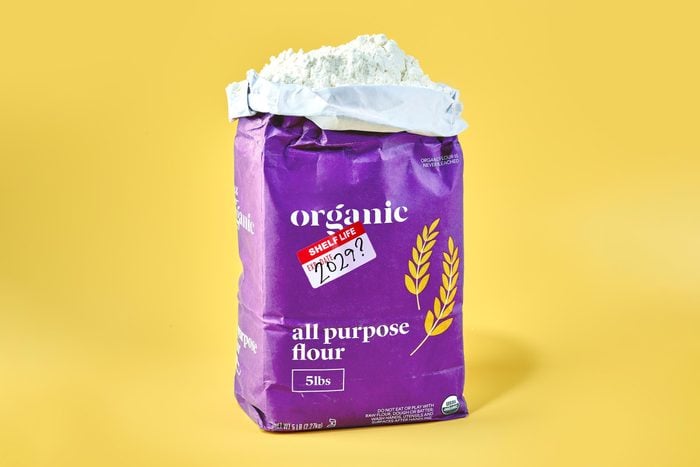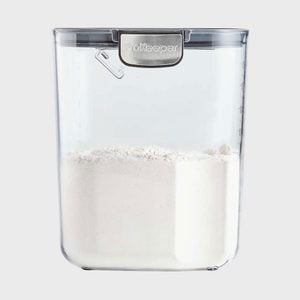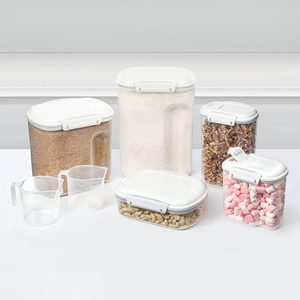Does Flour Go Bad? How to Know if Your Flour Is Expired
Updated: Nov. 03, 2023

Wondering if that flour in your pantry is still good? Get the lowdown on whether flour expires before you make your next batch of cookies.
You steered hard into the sourdough craze, and your starter is the pride of the pandemic. You perfected pie crusts and biscuits, and you now have a chocolate chip cookie recipe better than your grandma’s. While restaurants were closed, you nailed roux, flour-dusted breaded meats and more. But now that “normal” life has resumed, you’ve found that you now have too much flour and too little time. But can you keep your stockpile, or does flour go bad?
It’s a tricky question. After all, the FDA says that flour is an ingredient that has to be handled with care to avoid foodborne illness, but it is a pantry staple that lasts a lot longer than perishable foods. Aside from wondering if it’s a food that never expires, like honey or salt, you may have repackaged it in reusable containers, which means those sell-by dates are gone with the original packaging. But then again, do they even mean anything anyway? You may even wonder if there’s a difference in the amount of time you can keep one flour as opposed to another, like all-purpose flour vs. bread flour.
We’ve found ourselves asking the same questions. Here are the definitive answers from government agencies and professional pastry chefs on flour’s staying power.
Does flour expire?
Or, more accurately, does flour go bad? Surprisingly, yes. “Store-bought flours do have preservatives to keep them shelf-stable longer,” explains Krista Kirsch, a pastry chef at Atlanta’s Saints + Council, “[but] it’s important to have fresh flour.”
Flour is actually rather susceptible to spoilage because of the natural oils in the grain, nut or starch in it, and its shelf life partially depends on the fat content from these oils. The less refined it is, the more fat it will contain—and the faster it will go bad. For instance, processed white flour contains 1.81% fat, while whole-grain flour contains 3.63%. Therefore, the enriched white flour that more than 95% of Americans buy will last substantially longer than whole wheat, since there is less oil to spoil.
And while leaveners may be added to some types of flour, like self-rising varieties and mixes, most flour is just the raw grain, root, bean, nut or seed grain. The addition of ingredients like salt and baking powder, which do not go bad, does not affect the shelf life of the base flour type. However, it may affect performance.
How can you tell if flour is bad?
Honestly, it’s pretty hard to miss when flour’s past its prime. Fresh flour has a neutral, clean powder scent to it, if any at all, with the subtle sweetness of grain. Flour that’s turned will smell off, with a markedly sour, unpleasant mustiness to it. But if you already see traces of mold, you can go ahead and skip the sniff test—you definitely don’t want to inhale those spores! Signs of mold contamination can include visible clumps of green or blue growth. If you see clumps but not of these colors, you should probably discard it to be safe—that’s a sure sign of moisture exposure, a breeding ground for mold. In either case, according to the USDA’s Food Safety and Inspection Service, that entire bag is no longer usable since porous foods like flour products can be contaminated below the surface.
And if you doubt your sniffer, check the color for corroboration. All-purpose, bread, cake and other refined white flours should be bright white and fluffy; tapioca flour is also vibrantly snowy; whole grain is usually a sandy brown; and almond flour tends to be off-white, like the inside flesh of the nut. If you see a yellowish tinge to any of your flour, that’s a sign of oil that’s turned rancid.
Last, if you find any critters in your flour, discard it right away. Weevils, larvae and moths are common culprits, and while they won’t hurt you if you ingest them in a baked good (the heat will kill them), we’re betting this is extra protein you don’t really want! However, before you throw it out, freeze the flour first. This will kill the bugs and help you avoid a pest infestation in your garbage bin.
How long does flour last?
Similar to other kitchen staples, including items like canned foods, how long flour lasts depends on a variety of specific factors that center around flour type and how you store the flour. In the least ideal of circumstances—an unsealed bag left out—your mileage may max out in just three to eight months, and that’s for the longest-lasting of the bunch, refined white flour. On the other hand, if you put your flour in a sealed, airtight container and keep it cool and away from light, you’re looking at literal years of use from that one bag … if you don’t run out first!
However, as mentioned, the time frames vary significantly by flour type. While our best suggestion is to trust your nose, follow these guidelines if you’re wondering, Does flour go bad?
- Refined flour: This includes all-purpose, white bread, cake, pastry and self-rising flours made of wheat. Of those, lower-protein flours (like cake or pastry) will last the longest. Bread flour, which is higher in protein, since it’s made from hard wheat, will fall a few months short of that. Generally, though, when stored properly, processed bleached and white starch flours will remain usable for up to two years due to their low fat content.
- Self-rising flour: This is the only exception to the white refined flours. Its leavening agent, baking powder, will lose potency as time passes. When stored properly, it will perform as expected for only about a year.
- Whole wheat and whole grain flours: This broad category can encompass white as well as darker whole wheats, pumpernickel, whole and medium rye, buckwheat, oat and any other types of whole grains. These types of flours tend to go rancid at the year mark, even when stored in conditions that keep them away from the light, moisture and air the grains are so sensitive to.
- Starch-based flours: This non-wheat group can include potato, tapioca, cornstarch, sweet potato, chickpea and the deceptively named tiger nut, which is actually originally a North African tuber. If refined and white, they have a similar shelf life to their conventional all-purpose counterparts, which caps out at two years.
- Nut flours: Almonds, coconuts, macadamias, walnuts, pecans … almost any nut can be ground into flour. However, that won’t stop them from behaving like nuts when it comes to spoilage. That means they can become rancid in as little as six months, especially since these oils are no longer contained in the body of a nut but distributed throughout the flour.
- Gluten-free flours: While starch flours last for quite some time, gluten-free flour blends often introduce nuts to the mix, which shortens the time span in which you have to use them at peak quality. These can be stored for roughly six months (when done correctly).
Is expired flour OK to use?
Technically, “expired” flour doesn’t mean much—the dates printed are typically sell-by or best-by dates and peak-condition recommendations. According to the USDA, these dates do not denote safety. However, because flour does go bad, if the quality indicators signify that it’s past its prime, it’s best to chuck this pantry staple and buy a new bag. Why? Flour is one of those ingredients whose quality gets mirrored in the finished product. If it smells sour or musty on its own, those traits will be transferred to whatever you use it in, permeating your dish with this unpleasantness.
Additionally, flour that’s past its prime can change the texture of baked goods. Older flour has likely had more exposure to open air, which damages the protein structure of the grain. With a less stable chemical infrastructure, everything will be more crumbly, no matter what you’re baking.
In Kirsch’s experience, “using older flour results in a bread that doesn’t rise as nicely and is a bit more dry than when [it’s] fresh.” Eric Wolitzky, executive pastry chef of Fifth Group Restaurants, also notes that “when flour is old, it just doesn’t incorporate water as well, and the texture isn’t the same. For example, if you’re making homemade pizza, where you want it to be a little crispy but also a little chewy, you need the perfect balance of moisture to achieve that.”
Using old self-rising flour is another cooking mistake that may affect your baking. As mentioned, the leaveners in the blend are active for far less time than the flour itself stays of good quality. “With baking soda and other baking ingredients, you want them as fresh as possible,” says Wolitzky. So even if your flour smells OK, if it’s old, your baking project will fall flat.
Can old flour make you sick?
Usually not. While the molecular structure of flour does change when it goes rancid, the compounds that it produces aren’t harmful to humans in small amounts. It won’t taste very good, as we’ve noted, but it won’t make you physically ill, unless there’s mold in it. It’s the mold that can make you sick, since certain types produce mycotoxins that can trigger vomiting and diarrhea.
Even bugs like flour beetles, weevils and moth larvae won’t technically hurt you. But who wants to eat that?
How should you store flour?
According to the USDA, flour is considered a shelf-stable product, which means there is no risk to your physical safety if you store it at room temperature. However, to extend the life of your flour, there are a few neat tricks you can use.
First and foremost, you should always repackage or at least place your open bag of flour in an airtight sealed container, away from light, moisture and oxygen. These elements can degrade your flour quickly, causing it to be unusable or to spoil. Sealed gasket canisters like the Progressive ProKeeper Flour Storage Container or Sistema storage containers are perfect. For bulk quantities, the tidy-looking Hubee food-safe storage container is also a great pick. You can even use a sealed Ziploc bag if you’d like.
Can you refrigerate or freeze flour?
While the pantry is a fine solution for those who use their flour regularly, the refrigerator is an even better storage spot that can double flour’s shelf life. Just make sure to keep it away from moisture and anything in the fridge that could be moldy. Put it a sealed plastic storage bag or a closed container—preferably one that’s made of plastic or silicone, which can handle the cold without warping. Important note: Storing it in a metal container may give your flour a metallic taste.
The downside of storing your flour in the fridge is that you’ll need to plan ahead for the times that you do use it, since flour needs to come to room temperature before using. If it’s too cold, it will lump up in cooking applications or refuse to behave in your bread.
To maximize the amount of time you can keep your flour, you can also freeze it. If you choose this route, double-bag it to avoid other flavors (especially if you’re keeping it near meat) and stale air leeching into the flour. Again, though, you’ll need to thaw out what you need and let it warm before using. The good news is that it doesn’t take long to warm up, but wrestling with a frozen block of flour for a scant cup is something to consider.
Either way, these methods will help you increase the time before you need to head to the store to buy new flour. While baking is on your mind, check out our other stories on how fast butter expires and how long milk really lasts.
Sources:
- FDA: “Handling Flour Safely: What You Need to Know”
- Krista Kirsch, a pastry chef at Saints + Council in Atlanta
- Wheat Foods Council: “Types of Wheat Flour”
- USDA: “Molds on Food: Are They Dangerous?”
- USDA: “Food Product Dating”
- Eric Wolitzky, executive pastry chef of Fifth Group Restaurants







